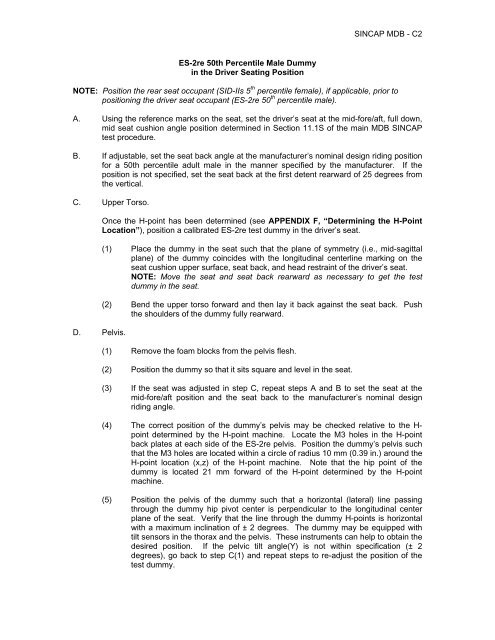U.S. DEPARTMENT OF TRANSPORTATION - SaferCar.gov
U.S. DEPARTMENT OF TRANSPORTATION - SaferCar.gov
U.S. DEPARTMENT OF TRANSPORTATION - SaferCar.gov
Create successful ePaper yourself
Turn your PDF publications into a flip-book with our unique Google optimized e-Paper software.
SINCAP MDB - C2<br />
ES-2re 50th Percentile Male Dummy<br />
in the Driver Seating Position<br />
NOTE: Position the rear seat occupant (SID-IIs 5 th percentile female), if applicable, prior to<br />
positioning the driver seat occupant (ES-2re 50 th percentile male).<br />
A. Using the reference marks on the seat, set the driver’s seat at the mid-fore/aft, full down,<br />
mid seat cushion angle position determined in Section 11.1S of the main MDB SINCAP<br />
test procedure.<br />
B. If adjustable, set the seat back angle at the manufacturer’s nominal design riding position<br />
for a 50th percentile adult male in the manner specified by the manufacturer. If the<br />
position is not specified, set the seat back at the first detent rearward of 25 degrees from<br />
the vertical.<br />
C. Upper Torso.<br />
D. Pelvis.<br />
Once the H-point has been determined (see APPENDIX F, “Determining the H-Point<br />
Location”), position a calibrated ES-2re test dummy in the driver’s seat.<br />
(1) Place the dummy in the seat such that the plane of symmetry (i.e., mid-sagittal<br />
plane) of the dummy coincides with the longitudinal centerline marking on the<br />
seat cushion upper surface, seat back, and head restraint of the driver’s seat.<br />
NOTE: Move the seat and seat back rearward as necessary to get the test<br />
dummy in the seat.<br />
(2) Bend the upper torso forward and then lay it back against the seat back. Push<br />
the shoulders of the dummy fully rearward.<br />
(1) Remove the foam blocks from the pelvis flesh.<br />
(2) Position the dummy so that it sits square and level in the seat.<br />
(3) If the seat was adjusted in step C, repeat steps A and B to set the seat at the<br />
mid-fore/aft position and the seat back to the manufacturer’s nominal design<br />
riding angle.<br />
(4) The correct position of the dummy’s pelvis may be checked relative to the H-<br />
point determined by the H-point machine. Locate the M3 holes in the H-point<br />
back plates at each side of the ES-2re pelvis. Position the dummy’s pelvis such<br />
that the M3 holes are located within a circle of radius 10 mm (0.39 in.) around the<br />
H-point location (x,z) of the H-point machine. Note that the hip point of the<br />
dummy is located 21 mm forward of the H-point determined by the H-point<br />
machine.<br />
(5) Position the pelvis of the dummy such that a horizontal (lateral) line passing<br />
through the dummy hip pivot center is perpendicular to the longitudinal center<br />
plane of the seat. Verify that the line through the dummy H-points is horizontal<br />
with a maximum inclination of ± 2 degrees. The dummy may be equipped with<br />
tilt sensors in the thorax and the pelvis. These instruments can help to obtain the<br />
desired position. If the pelvic tilt angle(Y) is not within specification (± 2<br />
degrees), go back to step C(1) and repeat steps to re-adjust the position of the<br />
test dummy.











